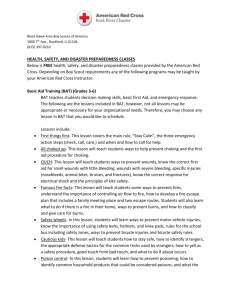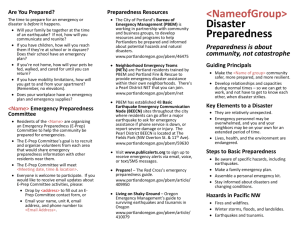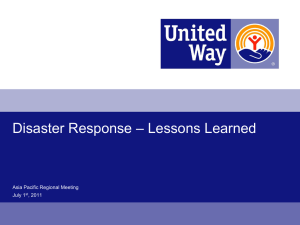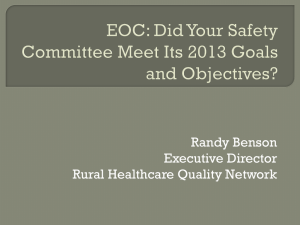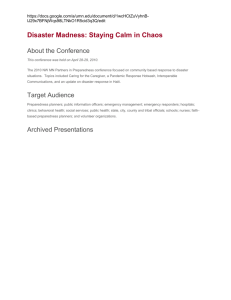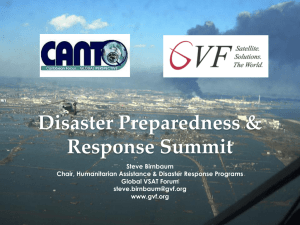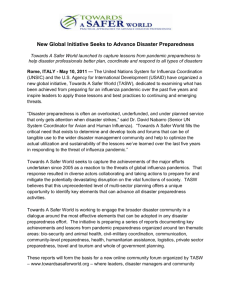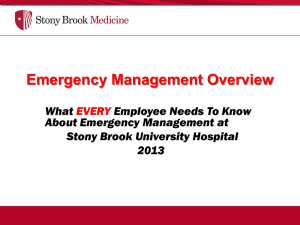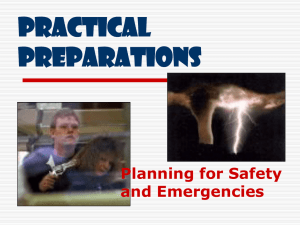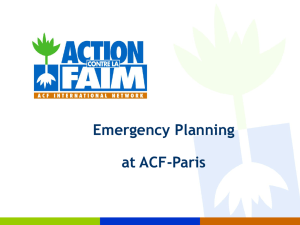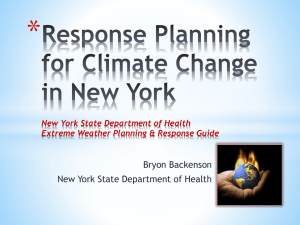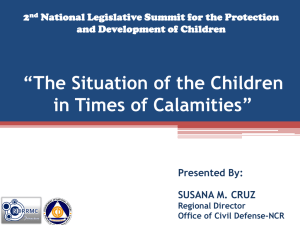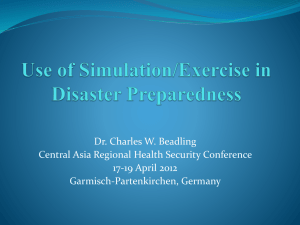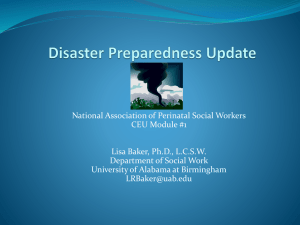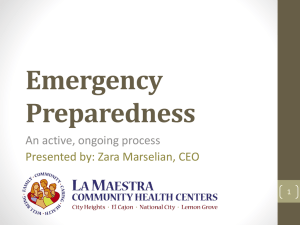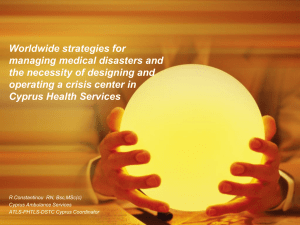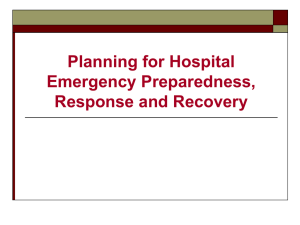EZ Techniques for Emergency Preparedness PPT
advertisement
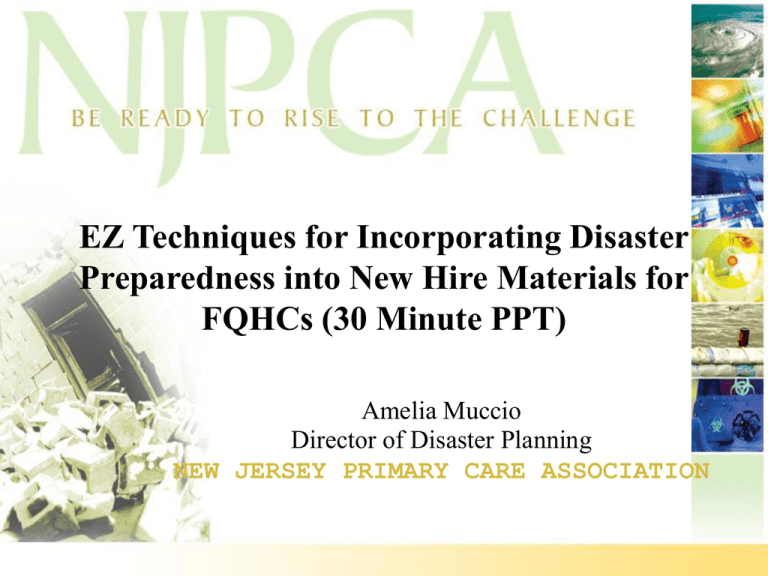
EZ Techniques for Incorporating Disaster Preparedness into New Hire Materials for FQHCs (30 Minute PPT) Amelia Muccio Director of Disaster Planning NEW JERSEY PRIMARY CARE ASSOCIATION Learning Objectives • Overview of NJPCA • Discuss barriers to EP buy in and preparedness • Discuss techniques for incorporating EP into CHC new hire orientations • Review successful models • Identify next steps for facility leadership . Community Health Centers: “Your Community, Your Health, Our Commitment.” • • • • • Number of Health Centers=20 Number of sites=100 Number of staff=1,600 Number of persons served=425,000 Over 1.3 million visits NJPCA’s Programs • Disaster Advisory Committee (1 rep every FQHC) • Family disaster planning/preparedness • IS 100, IS 200, IS 700 and IS 800 • Personal Protective Equipment (PPE) lecture • Hazard Vulnerability Analysis • Pandemic Flu Plans • Fit-Testing for N-95 respirators • • • • 14 elements of NIMS compliancy HRSA PIN Business continuity plan COOP Training Efforts (2005-2008) Disaster Education by Year 3500 Number Trained 3000 2500 Year 2005 2000 Year 2006 Year 2007 1500 Year 2008 1000 Total 500 0 Year IS Compliancy Compliancy with IS 100, 200, 700, 800 and HVA (7/08) Percent Completed 105% 100% IS 100 IS 200 IS 700 95% 90% IS 800 HVA 85% 80% Course/Item Emergency Preparedness… Rationale for Disaster Program: Health Center Investment (Sell It) • We are only as prepared as the lowest common denominator • Disaster planning assists with: – Ability to rotate staff – Organizational agility – Plans, drills, and evaluations – Training and education – Staff protection and support – Communications and reporting – Supplies and equipment – Obligation to community • Educating staff is an investment! Challenges Faced • • • • • • • • Overwhelming task Lack of clear guidance Time consuming Resource constraint No EP on staff Uneven knowledge Uninterested in subject Lacked buy-in • Disproportionate vulnerability and needs • High turnover rate in Centers • Lost revenue (not seeing patients) The Human Condition: “It Cannot Happen to Me!” The Science of Disaster Preparedness & Survival • Panic, fear and denial are inevitable in a disaster situation • Brain will perform best in a stressful situation if you have already put it through a few rehearsals – I.E. fire drills – Brain works in pattern recognition (respond quicker) Overcoming Challenges • Needs Assessment/Gap Analysis Data • Flexibility • Catered to specific needs • On-Site training • Buy-In (Lunch & Learn) • Tailor-Fit programs • Reinforce compliance • Provide continuing education credits • Ownership of program (train the trainer) How to Incorporate EP? • Why New Hires? – First impressions matter – Sets the tone and capabilities for expectations – Investment in employee – Influence how they work • EZ Approach—New hire orientation – Multiple formats • PPT (live or moderated) • DvD/video • SME presentation • local EP org or official • PCA presentation Focus on What You Can Control • Focus on mitigation and preparedness • CHC’s are planning for events (pandemic, hurricane, power outage, outbreak, terrorism) that require high levels of predisaster preparedness (prevention, and mitigation activities) • Disaster is reasonably expected and preparedness initiatives have been undertaken • Examples of low levels of predisaster preparedness, economic depression and longterm civil war Review Documents with Staff Review Plans—Demystify • • • • • • • • HVA (Hazard Vulnerability Analysis) EOP (Emergency Operating Plan) EMP (Emergency Management Program) CEM (Comprehensive Emergency Plan) SOP (Standard Operating Procedure) IAP (Incident Action Plan) Business Continuity (Continuity of Operations) Corrective Action (Lessons Learned/Hindsight Share Resources with Staff • Family Preparedness Plan – – – – Children Elderly/Disabled Pets Emergency Communication Plan – Evacuation & Sheltering • How to Construct a GoBag (supplies) • • • • • • • FEMA American Red Cross Ready.Gov 72hours.org ASPCA HSUS AARP Establish Personal Preparedness Plans First Aid Kits . Crank NOAA Weather Radios . Potable Water . Go Bags . Inside Go Bags . Rations, Stove and Tent . Cat and Dog Go Kit . Purchase Materials • • • • • • • • NOAA Weather Radio $20 Go Bag $40 Pet Go Bag $40 First Aid Kit $10 N-95s $10 Pan Flu Kit $15 Total: $135 Nominal Investment—will pay dividends! Walk the Walk—PCA Preparedness • • • • • • • • • PCA staff member has: IS 100, IS 200, IS 700 and IS 800 training Crisis Communication training Disaster Awareness training Go Bag NOAA Weather Radio First Aid Kit Pet Kit **All trainings were lunch and learns It’s a Process (Trial and Error) Questions? Amelia Muccio Amuccio@njpca.org (609)689-9930 ext. 26 “If you jump out the window at the 42nd floor and you're still doing fine as you pass the 27th floor, that does not mean you don't have a serious problem.” - Charles Munger



